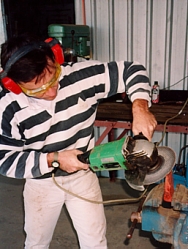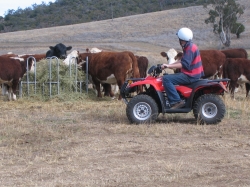Farm Safety Facts
On-farm injury is a major problem for the agriculture and horticulture industries in Australia.
Deaths - Non-intentional Farm Injury Deaths
Around 100 persons die from non-intentional injury on Australian farms each year. These deaths are of workers, bystanders to work and others and occur in a range of circumstances on farms of different agricultural enterprise types.
Road Traffic Accident Deaths of Farmers
Deaths of farmers and farm workers on roads appear to be an important cause of premature loss of life for this population. The search for preventable factors has begun with reporting of behavioural factors such as seat belt wearing and alcohol use being identified as significant contributors to road traffic deaths.
Between 300 and 350 traumatic deaths of male farmers and farm workers from all causes (non-intentional and intentional) occur each year across Australia.
Workers Compensation Claims
There are close to 4,500 workers compensation claims each year of workers in the agriculture and horticulture industries. This does not include claims for workers in services to agriculture that includes shearers and other contract workers, for which there are a further 830 claims per annum. Claims rates for Agriculture and services to Agriculture are amongst the highest of any industry. The sheep shearing industries are associated with very high rates of claims and costs.
Admissions to Hospital for Farm Injury
Examination of hospitals data indicates the importance of motorcycle, other vehicles, horses, farm machinery and animals as agents of farm injury.
Hospitals data has been used to profile specific farm injury problems – causes of child farm injury admissions to hospitals, age/ sex characteristics of persons admitted with farm injury associated with specific agents of injury – farm machinery, “animals ridden” (horses) motorcycles.
Managing Farm Safety
Farmsafe Australia has developed a series of resources for farmers and farm managers to manage safety on their farms.
The Managing Farm Safety resources include hazard checklists, safety induction forms for farm employees and contractors, Safety Guides and templates to record farm safety training and injury.
These resources can be downloaded by following this link to the AgHealth Australia website.
Managing Farm Safety resources are available for the following agricultural inustries:
- Dairy
- Sheep and Wool Production
- Grain Production
- Cotton
- Beef Cattle
- Horticulture
- Sugarcane
Hard copies of these resources can also be purchased from AgHealth Australia or by contacting Farmsafe Australia.
Child Safety on Farms
Farms are great places for children to grow and develop, when we create a supportive environment, but safety for children on farms is a major concern.
Around 20 children under 15 years are fatally injured on an Australian farm every year and many more are hospitalised or treated by General Practitioners across rural Australia. The major causes of child deaths and injuries on farms are dams, farm vehicles, machinery, motorcycles and horses. Age and development characteristics also place children at greater risk.
A recent study of on-farm fatalities from 2001-2004 by the Australian Centre for Agricultural Health and Safety found that:
- Children (0-14yrs) make up 15-20% of farm injury deaths, around 66% are male.
The main agents of fatality and serious injury are:
- Drowning in dams
- ATVs or 4 wheeled motorbikes
- Farm vehicles (cars, utes)
- Around 25% of all child deaths were visitors to the farm, but 50% of those killed on ATVs were visitors. ATVs are also the most common cause of death for children 5-14 yrs on farms
- Drowning accounts for around 35-40% of all on child farm deaths, with farm dams being by far the most common site and children under five years at greatest risk.
There has been an improvement in the reduction of toddler drowning on farms in recent years – particularly a reduction of drowning in dams, which have halved since the 1990’s. However, drowning is still the number one cause of child farm fatality in Australia.
A common scenario is that a toddler wanders away from the home un-noticed into farm water bodies or toward other farm hazards (vehicles, mobile machinery). Apart from dams, children can find their way into creeks, troughs, dips and irrigation channels. Children under five years of age are at greatest risk.
For non-fatal injury of children on farms, older children (5 - 14 yrs) figure more prominently - particularly in relation to injury from 2 and 4 wheeled motorbikes (and horses). Whilst there tends to be more hospital Emergency Department presentations for 2-wheeled motorbikes, injuries from ATVs are likely to be more severe or fatal. There are four times as many children being killed riding ATVs than 2 wheel motorbikes on farms (NFIDC, 2007).
Priorities for Child safety on Farms
Priorities for child safety on farms were developed by Farmsafe Australia, based on consultation with peak farmer groups and research of injury solutions by the Australian Centre for Agricultural Health and Safety. These are for farm families to:
- Have a securely fenced house yard (safe play area) for young children to play, unless an adult is available to closely supervise them on farm.
Ensure all children:
- Always wear seatbelts and restraints when in cars, utes and trucks
- Don't ride on tractors, ATVs or in the back of utes
- Always wear helmets when riding bikes and horses
Whilst these are short-list priorities, families still need to identify and address other hazards and risks specific to their farm. Controlling these risks should commence with reducing hazards and designing for safety where possible. See below for further information and links to resources.Child farm injury in Australia.
Child Safety on Farms Checklist
Safe Play Areas on Farm (pamphlet)
Safe Play Areas on Farms: A Resource Booklet
Childcare Options for Farming Families (factsheet)
Get Going, Moving Kids Safely on Farms (booklet)
Noise Injury and Hearing Safety
Noise injury and hearing loss is a significant problem in the Australian farming community. Hearing loss sustained from noise injury, can have disabling personal and social consequences for the affected person and their family.
Research has shown that around two-thirds of farmers have a measurable hearing loss, or have on average, hearing levels 10 to 15 years worse than that of the rest of the population.
Noise injury in farmers occurs from prolonged exposure to on-farm noise hazards such as tractors, chainsaws, firearms. Damage can be caused by prolonged and cumulative effects of noise over 85 dB over many years; or by instant trauma associated with peak noise levels over 140 dB. Exposure to excessive noise levels without protection, is an unacceptable risk to the hearing health of farming families.

Noise Injury Prevention on Farms
Summary factsheets for farmers based on research conducted by the Australian Centre for Agricultural Health and Safety are provided below.
Rural Noise Factsheet
Farm Noise Pamphlet
Shooting Hearing Flyer
Farm Workshop Safety
People working in the farm workshop are exposed to risk of injury and illness associated with a range of hazards. Up to 20% of farm injuries presenting to hospital Emergency Departments are caused by farm maintenance work. More than 30% of these are eye injuries and more than 30% are hand injuries.
Hazards associated with work in the farm workshop include:
- Poor workshop design and layout
- Electricity
- Welding
- Oxyacetylene welding and cutting
- Grinding
- Using power hoists
- Using power and hand tools
- Battery charging
- Tyre changing
The types of injury range from death, serious injury requiring hospitalisation and down time, to “nuisance” injuries that stops work for a short time, or makes work slower and reduces productivity.
The following Farm Workshop Safety Guide has information and practical solutions to improving farm workshop safety.
Rural Noise Factsheet
Farm Noise Pamphlet
Shooting Hearing Flyer
Vehicle and Motorbike Safety
Four wheeled motorbikes or quadbikes are becoming a leading cause of death and serious injury on Australian farms. There are on average 12 farm quadbike related fatalities on Australian farms every year.
Whilst there have been significant farm safety success with the reduction of death and injury associated with tractor use on farms, and a reduction in the child related injury, quadbike and vehicle related injury is a major concern.
Farmsafe Australia have developed an Safety Guide for farmers, that can help farmers reduce the risk of serious injury associated with quadbike use on farm.
When farmers are considering using four whelled motorbikes for work on farms, Farmsafe encourage the following safety principles:
- Is the quadbike the most appropriate vehicle to do the job? A farm ute or small Utility Vehicle is better to carry passengers and heavy loads safely.
- When riding a quadbike, always wear a helmet.
- Always keep the quadbike well maintained and tyres correctly inflated according to manufacturers reccommendations.
- DO NOT allow riders under 16 years old to operate a quadbike.
- DO NOT carry passengers and
- DO NOT carry heavy loads or overload a quadbike. They become more unstable and may roll causing fatal crushing injuries.
More information can be found by downloading and reading the Farm Quad Bike Safety Guide.
Farm Quad Bike Safety Guide
Tractor and Machinery Safety
Grain Auger Safety
Many grain augers used on farms have had the guard over the flight intake removed and not replaced.
Often these have been removed so that the auger can be used for grains that do not flow easily through the narrow mesh of the guard.
There is, on average, 1 death and 16 workers’ compensation claims per year involving grain augers. There will be many more injuries, as most day-to-day work on farms is done by self employed farmers and their families, and these injuries will not be included in the official workers compensation figures. It’s likely that there are around 60 serious injuries involving farm augers each year.
Most injuries are crush injury or amputation of fingers, hands, arms and feet caused by limbs being caught in unguarded auger flights. Effective guarding would prevent these serious injuries.
The guard is designed in two parts, a fixed inner guard and an outer guard that can be removed when the auger is used in silos, grain bins or in a guarded hopper, AND THEN BE EASILY REPLACED.
This guide provides farmers with practical information to build and retrofit a guard to older grain augers, improving safety of those people handling grain and using grain augers.
Auger Guarding Guide
Farm Machinery Guarding
Acknowledgement
This information is courtesy of Farmsafe Australia Inc.



